
A lichen is a composite organism that arises from algae or cyanobacteria living among filaments of multiple fungi species in a mutualistic relationship. The combined lichen has properties different from those of its component organisms. Lichens come in many colors, sizes, and forms. The properties are sometimes plant-like, but lichens are not plants. Lichens may have tiny, leafless branches (fruticose), flat leaf-like structures (foliose), flakes that lie on the surface like peeling paint (crustose), a powder-like appearance (leprose), or other growth forms.

Erik Acharius was a Swedish botanist who pioneered the taxonomy of lichens and is known as the "father of lichenology" and famously the last pupil of Carl Linnaeus.

Usnea is a genus of mostly pale grayish-green fruticose lichens that grow like leafless mini-shrubs or tassels anchored on bark or twigs. The genus is in the family Parmeliaceae. It grows all over the world.
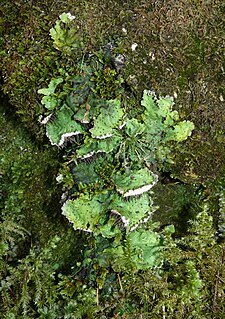
Peltigera is a genus of approximately 91 species of foliose lichens in the family Peltigeraceae. Commonly known as the dog lichen, lichens of Peltigera are often terricolous, but can also occur on moss, trees, rocks, and many other substrates in many parts of the world.

Rock tripe is the common name for various lichens of the genus Umbilicaria that grow on rocks. They can be found throughout northern parts of North America such as New England and the Rocky Mountains. They are edible when properly prepared and have been used as a famine food in extreme cases when other food sources were unavailable, as by early American northern explorers.
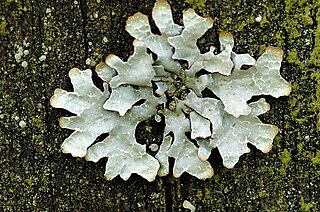
Parmelia sulcata is a foliose lichen in the family Parmeliaceae. It is very tolerant of pollution and has a cosmopolitan distribution, making it one of the most common lichens. It harbours a unicellular Trebouxia green algal symbiont.

Aspicilia is a genus of mostly crustose areolate lichens that grow on rock. Most members have black apothecia discs that are slightly immersed in the areolas, hence the common name.

Caloplaca is a lichen genus, composed of a number of distinct species. Members of the genus are commonly called firedot lichen, jewel lichen. gold lichens, "orange lichens", but they are not always orange, as in the case of C. albovariegata. The distribution of this lichen genus is worldwide, extending from Antarctica to the high Arctic. It includes a portion of northern North America and the Russian High Arctic. There are about thirty species of Caloplaca in the flora of the British Isles. An example species in this genus is Caloplaca saxicola, a lichen with worldwide distribution including the Antarctic continent, Europe and northern North America including the northern reaches of the Canadian boreal forests.
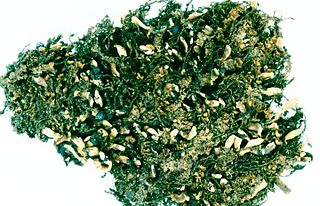
Cetradonia is a lichen and the only genus in the family Cetradoniaceae. A monotypic genus, Cetradonia contains the single species Cetradonia linearis. The genus was circumscribed in 2002.
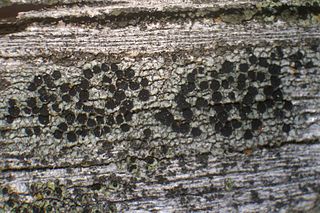
Buellia is a genus of fungi in the family Caliciaceae. The fungi are usually part of a crustose lichen. In this case, the lichen species is given the same name as the fungus. But members may also grow as parasites on lichens (lichenicolous). The algae in the lichen is always a member of the genus Trebouxia.

Xanthoparmelia is a genus of foliose lichen in the Parmeliaceae family. Xanthoparmelia is synonymous with Almbornia, Neofuscelia, Chondropsis, Namakwa, Paraparmelia, and Xanthomaculina. This family of lichen is commonly found on the mid-east coast of the United States.
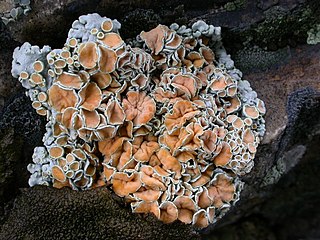
Rhizoplaca is a genus of lichenized fungi in the Lecanoraceae family. Members of the genus are commonly called rimmed navel lichens because of their umbillicate growth form and lecanorine apothecia, also rock-posy lichen and rockbright. The genus has a widespread distribution and contains 11 species.
Ameliella is a genus of lichenized fungi in the Lecanoraceae family. Described in 2008, the genus contains two species, A. andreaeicola and A. grisea, that were collected from high elevations in the Scottish Highlands. The two species have also been found in single instances in British Columbia and Northern Norway. The generic name is derived from the Greek ameleo, meaning "neglected" or "overlooked"; it was originally intended to be Amelia, which is also the first name of the daughter of one of the authors, but this name had previously been used for another genus and was therefore ineligible for use according to the rules of mycological nomenclature. Ameliella appears to have some similarity with the lichen genus Miriquidica.

Dictyonema is a large and diverse genus of mainly tropical basidiolichens in the family Hygrophoraceae.

Niebla is a genus of yellow-green fruticose lichens that grow on rocks, trees, and shrubs within the fog zone of coastal North America, or more narrowly defined to occur on rocks and soil along the Pacific Coast from Mendocino County in California south to Baja California Sur.
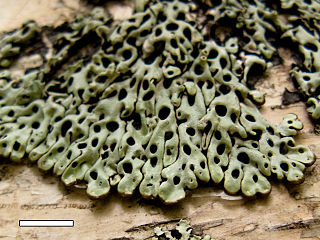
Menegazzia is a genus of lichenized fungi containing roughly 70 accepted species. The group is sometimes referred to as the tree flutes, honeycombed lichens, or hole-punch lichens. The most obvious morphological feature of the genus is the distinctive perforations spread across the upper side of the thallus. This makes the group easy to recognise, even for those not particularly familiar with lichen identification.

Haematomma is a genus of lichens. Commonly called bloodstain lichens, the species assigned to this genus are widely distributed in tropical and temperate areas. Haematomma is the sole genus in the monotypic family Haematommataceae.

A lichen has lecanorine fruiting body parts if they are shaped like a plate with a ring around them, and that ring is made of tissue similar to the main non-fruiting body part of the lichen. The name comes from the name of the lichen genus Lecanora, whose members have such apothecia. If a lichen has lecanorine apothecia, the lichen itself is sometimes described as being lecanorine.

















